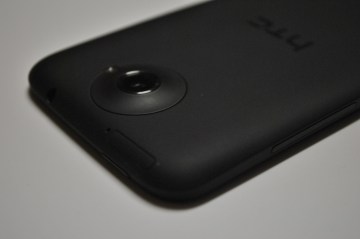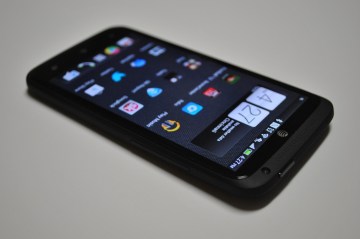Let’s kick off this HTC One X+ review by dealing with the elephant in the room.
If you’re an Android phone maker today, you need to answer a fundamental question: Why should someone buy this instead of Samsung‘s Galaxy S III? (Yes, I’m riffing on a similar question once posed by my colleague, Harry McCracken.) Because the reality is that Samsung’s savvy marketing–plus the fact that it makes great phones–have allowed the Galaxy S III to become widely available across all wireless carriers, and therefore wildly popular. It’s simply the standard for anyone who’s not buying an iPhone, and other phone makers need to wrestle with that.
For the last week or so, I’ve been using an HTC One X+ on AT&T, which sells for $200 on-contract. It’s an update to the earlier One X in a few key areas: It has a faster processor, a bigger battery, more storage and a newer version of Android. You know what? Those are exactly the same advantages the One X+ holds over the Galaxy S III, except for the equally-sized battery. The question is whether those differences, and others, are enough to help the One X+ stand out.
(MORE: Compared: HTC’s One X, One S and Evo 4G LTE)
It’s a nicely-designed phone, covered in grippy, soft-touch plastic with comfortable, rounded corners. The edges of the One X+ are angled slightly inward, helping to frame the hand while making the 4.7-inch, 1280-by-720 S-LCD display appear to thrust toward the user. It’s a gorgeous screen too; while it doesn’t have the pop of an AMOLED display, you couldn’t see a pixel on it if you tried.
Like HTC’s other recent Android phones, the One X+ has three capacitive buttons on the bottom: one for back, one for home, and one for a list of recent apps. You can switch that last one to a menu button, so it’s more like the Galaxy S III. If you don’t, some apps will clog up screen real estate with a big black bar dedicated only to the menu, so I think switching the hardware button’s functionality is the way to go.

My only gripes with the design are that the power button is on top, rather than the side, where it’d be easier to hit, and that the volume rocker is so flush with the side of the device that it always takes an effort to find and press. I also never got used to the placement of the microUSB charger on the upper-left edge of the phone, but that’s really a minor complaint.
But what about those specs, the ones that help the One X+ stand above its rival, at least on paper?
The truth is that most of them don’t make a huge difference. The One X+ is no slouch at basic tasks, but I did notice some minor stutters while flipping through the home screen, and some choppiness while playing Dead Trigger, a game that’s supposed to be optimized for this phone’s Tegra 3 processor. It has half the RAM of the Galaxy S III’s U.S. version, at 1 GB, but that never became a problem for me while switching between apps.
(MORE: New HTC Android Phones Tweaked to Evade Apple Patents)
As for battery life, I found that the One X+ got through most days of moderate use without a problem, but on travel days where I was regularly fiddling with it, placing calls and listening to streaming music, the phone ran out of juice just before bedtime. It’s not a phone you can use constantly without worry, and keep in mind that the battery is non-replaceable.
In the camera department, HTC and Samsung are basically equals–unrivaled ones, at that–with instant shutter speeds that produce excellent 8-megapixel photos. The camera app provides quick access to key features like flash and filter effects, and you can easily snap several photos in a row by holding the shutter button down. I particularly like the feature that lets you snap photos from a video you’ve already recorded; it works really well, even in fast-motion situations.

The rest of HTC’s Sense interface is hit-or-miss. The lock screen, which lets you quickly jump into a few favorite apps, is still one of HTC’s most clever software features, and the software in general is a lot smoother and less obnoxious than it used to be. The software keyboard on the One X+ is fast and accurate, and it has Swype-like gesture typing built-in. On the downside, HTC’s use of pea-green accents throughout its software is an undesirable remnant of Android’s earlier days, and as a whole I wish the visual style of the interface hewed closer to stock Android’s futuristic vibes. Also, the lack of quick settings access via the notification area is a drawback, but at least HTC provides a decent amount of toggle widgets that you can add to the home screen.
In the end, the HTC One X+ isn’t a major leap over the Galaxy S III, but I came away thinking it’s a slightly better phone for a few other reasons: It has loads more storage, at a whopping 64 GB, and I shamefully admit liking the phone’s Beats Audio integration for listening to music through headphones, even though I know the excessive bass is drowning out all kinds of nuance. The fact that the One X+ comes pre-loaded with Android 4.1, including the increasingly useful Google Now, is a nice bonus, and in principle I appreciate that HTC doesn’t get in your face with gimmicky software features like Samsung does with the pointless S-Voice virtual assistant.
I’m not sure whether all of that provides a crystal-clear answer to the fundamental question at the top of this review. But if you’ve been thinking about picking up a Galaxy S III, the One X+ does raise another question of its own: Why wouldn’t you at least consider something a little better?

